Radical farm makeover – George Young, Curtis Farm
Under conversion since autumn 2020
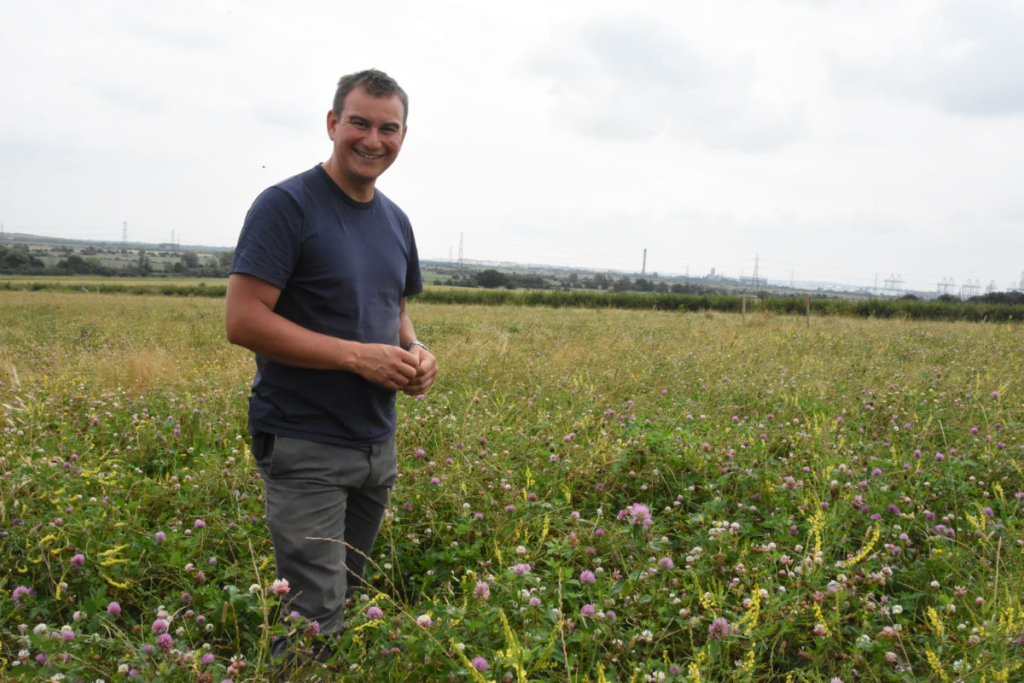
Getting to Curtis Farm isn’t easy, at least not when you take the wrong exit in the maze of motorway intersections and end up navigating the interlinked roundabouts in Basildon that seem to literally take you round in circles.
Standing at the farm gate you can make out the industrial units and the cranes of the London Gateway Port on the horizon which makes the farm even more of a green and beautiful oasis.
This morning, though, there is no time to ponder the contrasts. Vet Olivia is there to do TB tests on 12 maiden heifers. One by one, George Young and his father Andrew move the beautiful Red Poll cows into the chute they have set up on one of the paddocks. Then Olivia shaves the hair off two tiny patches on the neck. Avian flu is harmless for cattle, but most have antibodies and she needs to test for both avian and bovine TB to get a clear result when she checks the reaction to the injections in three days time. George Young is not worried. Basildon is a low risk area, but Young bought them from Northampton, a high risk region, and regulations require a TB test before the cattle are moved and a follow-up 60-120 days after their arrival at their new home. After the procedure and out of the chute again the heifers start grazing contently and later join the other cattle on the farm.
Oil futures and playing the saxophone
Buying cattle is one of many things George Young, now 35, has done since he returned to the farm in 2013.
Music, playing saxophone and clarinet, had been his passion growing up. But as becoming a professional musician isn’t exactly a safe career choice, Young moved to London having studied maths at university in Edinburgh. When he joined a bank as oil commodity trader he often needed to work late and there was little time to play saxophone in his band. When, in the aftermath of the financial crisis, the bank reneged on a promised raise and didn’t pay a bonus either, Andrew Young told his rather frustrated son: “You don’t really like it, why don’t you come back to the farm”. Which he did.
Thinking about soil
At the time, Andrew Young managed the roughly 1,200 acre farm conventionally. The main crops were wheat, rape seed and peas. Like many farmers, Andrew Young had moved to shallow tillage (min-till), but used all the agro-chemicals that his agronomist recommended.
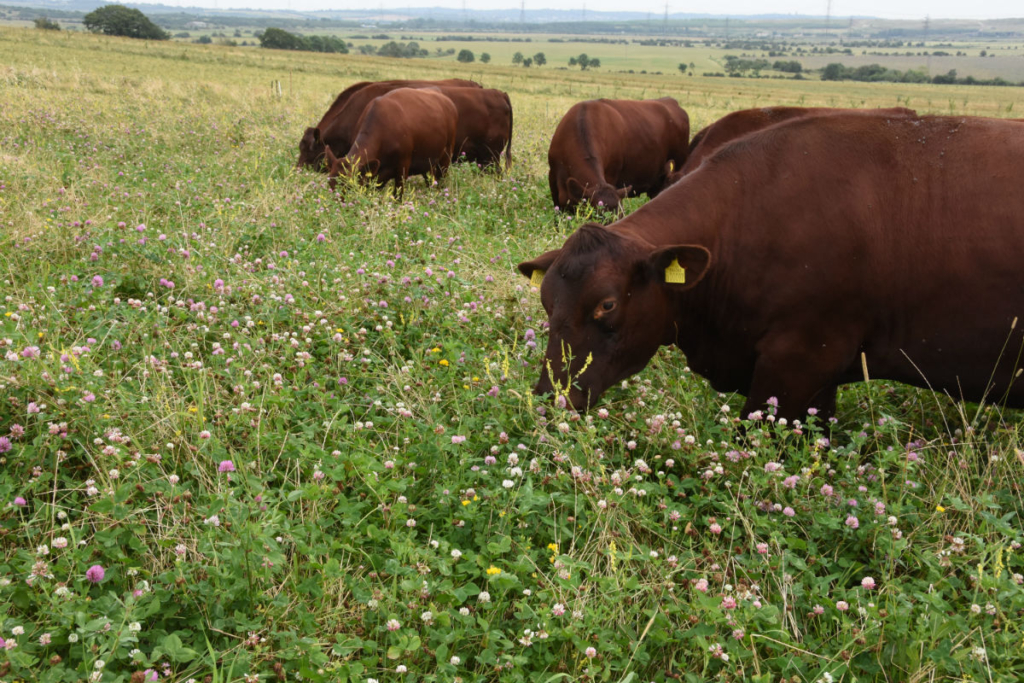
When George Young moved home, he started to look for alternatives. He visited another Essex farmer, Simon Cowell, who farms no-till (without any cultivation at all), and Young loved the spongey quality of the soil. It made him think differently about cause and effect in farming and convinced him to also go no-till.
After a few years of being no-till, including planting cover crops over winter which would be terminated with glyphosate in spring, it was clear that there were still issues with the system. “We were told that if we did this, the water in the drainage ditches would run clear”, remembers Andrew Young. When the water run-off from the fields continued to be muddy “we started to realise there was a problem with the soil”.
Over these years, George had begun to think seriously about the agrichemicals that he was using. He always disliked insecticides because he cares about insects, all insects, not just pollinators.
He had similar issues with fungicides which negatively impact soil mycorrhiza, and finally he understood that chemical fertiliser promotes plant growth, but simultaneously creates a pest problem: because of the plentiful nitrogen the plants have more sugar in the leaves, and that attracts pests and leads farmers to apply pesticides. And below ground, because the plants are “spoon-feed” nitrogen but little else, the root systems don’t develop well, the plants are weaker, which attracts disease and provides an opportunity for weeds. A vicious circle has been set in motion.
In spring of 2021, George direct seeded wheat in cover crops which he terminated two weeks after the wheat was sown (using glyphosate) just before wheat emerged. A couple of weeks later he walked the field and saw the brown, wilted remains of what had been healthy cover crop plants and thought: “How can you have a farming system that is based on chemically killing things, with all the ecological destruction that follows”. A few weeks later a farm worker overfilled a sprayer tank and some of the bright yellow pesticide spilled into the yard. The next few weeks were dry and the yellow stain was a constant reminder of what had happened; then came the rain and for days there was a strong chemical smell until the last of the pesticide had washed off. The spill was minor, but for George Young it was the incident that ended a long process of thinking, information gathering and discussions – the decision was clear: the whole farm would get a radical makeover. Starting now.
Going organic
A few months earlier, in September 2020, Young had already started organic conversion on the main part of the farm which means he will be able to establish his first organic crop on October 1st, 2022.
Eventually, he plans to work with a seven year rotation: four years of herbal leys which will be grazed, followed by three years of arable crops. The first year will be ideal for high protein wheat for bread, followed by pulses and soft wheat for cakes, buckwheat or hemp in the final year.
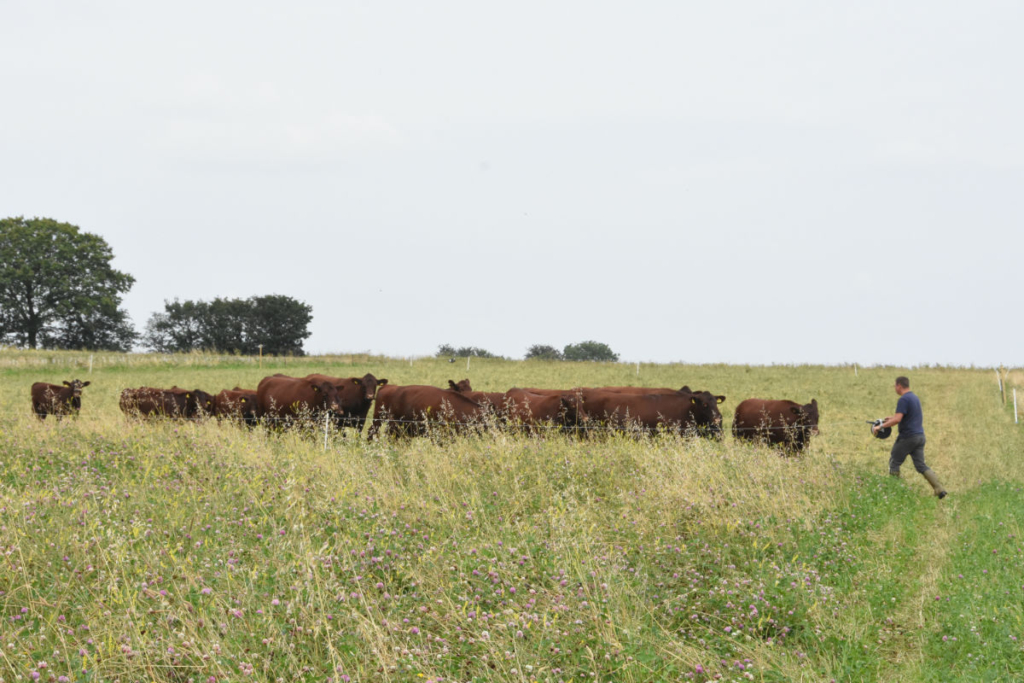
The cows need moving once a day and the time is now! As we walk across the farm they make themselves heard, loudly. The herbal leys consists of a 28 species mix including sweet, white and red clover, tall and wonderfully fragrant Persian clover birds foot trefoil, grasses, lucerne, sainfoin, yarrow, sheep’s parsley, burnet and chicory. Some of the plants are high in tannins and the cows use them to “self-medicate”. Young has used a simple electric fence to divide the pasture into small plots. The cows have grazed their plot clean and it will now rest for at least 40 days until the plants have regrown. As soon as George Young moves the fence the cows head into the neighbouring paddock where grasses and clovers reach up to their bellies. As we talk, bull Kestrel comes to the fence, head down. “No need to worry”, says Young, “he just wants me to brush the flies off his neck”.
As he pats Kestrel’s neck, he explains why he chose Red Polls: they are a native breed and local to this area. The cows calve easily and they will be able to stay on pasture year round. They are good natured and naturally have no horns which makes them easier and safer to handle. And Red Polls are a dual purpose breed, they can be raised for milk or meat.
There is a system to being radical
From where we are standing we can see some of the 7,000 trees Young began planting last year. He chose a wide variety of species including ‘exotic’ trees such as persimmon and olives, but mostly woodland trees, willow for mulching, nut and fruit trees. “We have a very special microclimate in this part of Essex, it’s similar to that in Brittany and ideal for growing apples and pears”, says Young. The space between the rows measures 36 metres. That gives him a wide enough alley to plant crops and enough room to extend the space along the trees. Eventually he would love to have a market gardener grow vegetables on the farm and possibly a future agroforestry project would have tree belts set out like forest gardens..
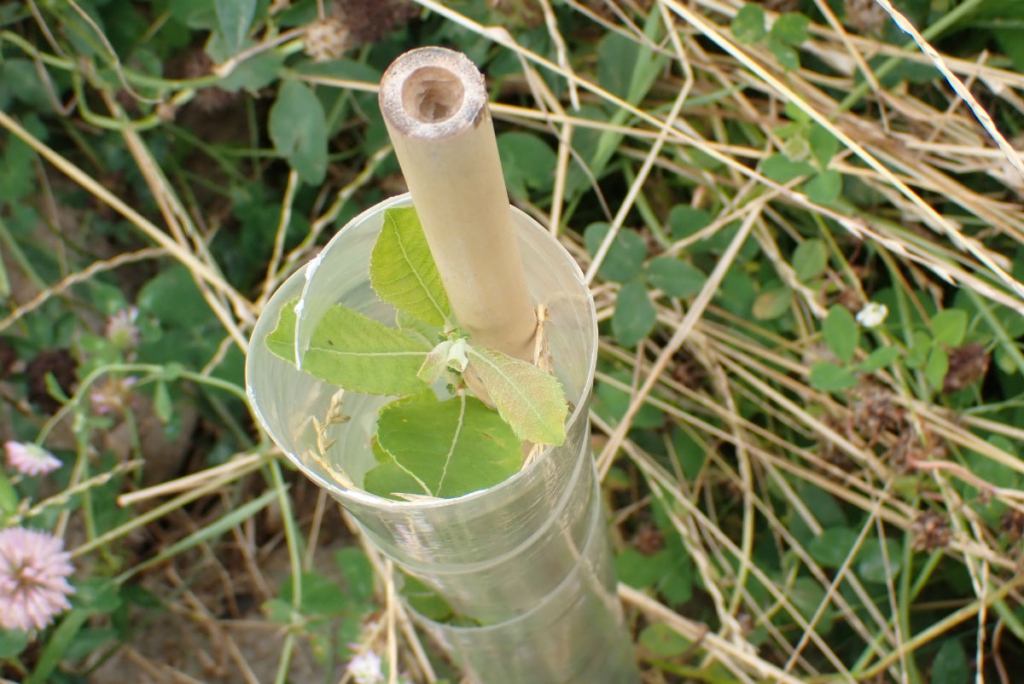
Young wants the tree belts to be connected to field margins to create a continuous habitat belt for wildlife and beneficial insects throughout the farm. At present he still grows a winter bird mix under a paid stewardship scheme, but “what’s the point”, says Young, “birds need food in summer too”. He wants to rewild the margins to create year-round habitats for as many species as possible.
Organic makes economic sense
If that makes Young sound like some kind of eco-warrior – he is not. The decision to go organic and farm the way he does are based on economic considerations. “My observational skills and my senses are most important to what I do in farming”, says Young who regularly walks the farm, not to do a particular job but to observe and think. “When you grow conventionally, your cash flow depends solely on the harvest: four weeks in the year. The rest of the time you have to invest. And even the harvest can’t be sold immediately, first you have to reinvest by planting the next crop. That is ludicrous!” On one of his farm walks he realised that the grains weren’t looking good, but the hedgerows had loads of fruit. “That’s resilience: If one crop is really poor, another one will be good”. The aim of his radical farm makeover is to diversify as much as possible and to spread the risk.
Initially, going for organic certification was an economic decision: “If I want to get a good price I need certification, it is not enough to just farm organically. But since I started conversion, I’ve become convinced that I need to create a farm system that is in balance. If it is not in balance, we are not doing it right”.
Adding value on farm
George Young tries to balance things on a multitude of levels: he wants to build up the cow herd to around 150 animals, a number that might justify employing a stockman. He also wants to keep sheep – their grazing behaviour is different from that of cows which is beneficial for the growth of pastures and herbal lays and it breaks the pest cycle: worms that plague sheep don’t bother cows and vice versa. Poultry could follow cows and sheep and the wild area could sustain six pigs, Young is thinking about Tamworth which could also be “employed” to terminate some cover crops and do some light ploughing. In two years time he hopes there will be enough livestock to merit on farm slaughter and the employment of a butcher. This would not only add value to the meat, he would be able to keep blood and bone meal on the farm and compost it with cuttings from willow and hazel to use as mulch around the trees.
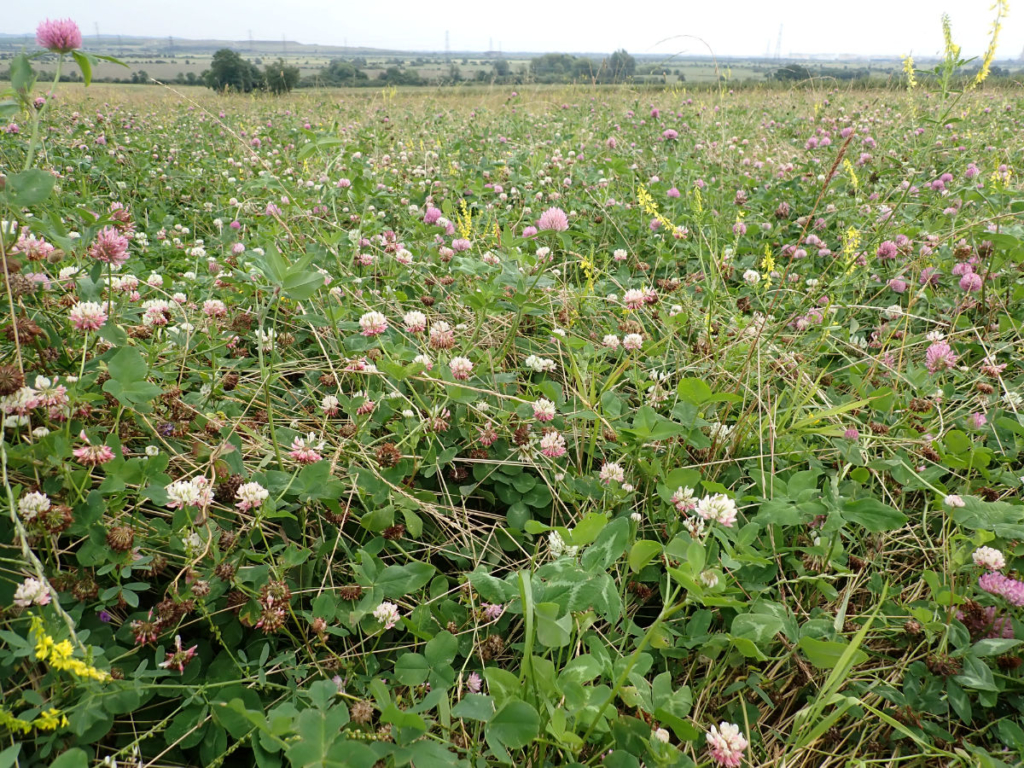
Everything on the farm is thought through, costed and carefully planned. Young intends to produce mostly heritage wheat which he will mill on farm – he has just invested in a stone mill from Vermont, and the milling room with a cleaning and packing unit is nearly ready. He will save seed for planting to locally adapt it and with the wheat being a niche product, processed on farm, he hopes to get a very good price selling to artisan bakeries – of which there are many in and around London.
Real food
“Farmers are wholesalers, not retailers”, says Young. He wants to produce the most nutritious produce and he wants his wheat to go into carefully made bread that truly nourishes those who eat it, but making the bread will be the job of a good baker. The same goes for meat butchered on farm: he plans to sell whole carcasses or halves to butchers and restaurants, and it will be their job to produce different cuts, sausages or complete meals.
Could he imagine having artisan food producers set up shop on the farm? Right now that would be a step too far, even for George Young. “I want to keep control over what happens on the farm until I am sure we are getting it about 80 percent right”, he says. The last 20 percent come with special knowledge and expertise and that’s when he will hire staff – for example someone to set up and run a market garden – with the perspective that one day they might buy into the business. But that’s way down the road.
The ORC – farm family and help when you need it
For now there are a whole lot of other issues to deal with and problems to solve. For Young, Brexit is what it is. He expects a lot of cheap food imports to come into the UK as a result of the trade deals. “Some of that food is not produced under conditions consumers want to see. Up to now, maybe 5 percent of consumers cared about where and how their food was grown and produced. Now the trade deals, together with COVID and the export problems we are facing, have raised awareness. Maybe we’ll get to 20 percent of people caring about the nutritional value of their food. I am taking myself out of the commodities market and will no longer be a price taker”.
This is the clear sighted view of a former commodity trader, but making it work on the farm, on the ground and all at once is hard. George Young is at home on social media, often there is immediate help and advice available via twitter. Still, during COVID he realised how cut off from everyone he was, how he missed the exchange with other, like minded farmers. For him it was particularly noticeable because he was about to introduce so many radical changes on the farm just when COVID struck and he was most in need of help and advice. Young joined the ORC some four years ago. Having access to the research was hugely valuable and just how important ORC farm events are became clear to him when they couldn’t happen anymore, due to the pandemic. “You network, you meet other farmers who think like you, you can discuss problems, ask them what they have done. These farmers are my kin, they are my tribe”. Exchanging information, communicating what he does, helping others to change their farm systems and go down the organic and sustainable route are hugely important to him. And when that’s all done he sometimes still can find a little time for music and for playing the saxophone.
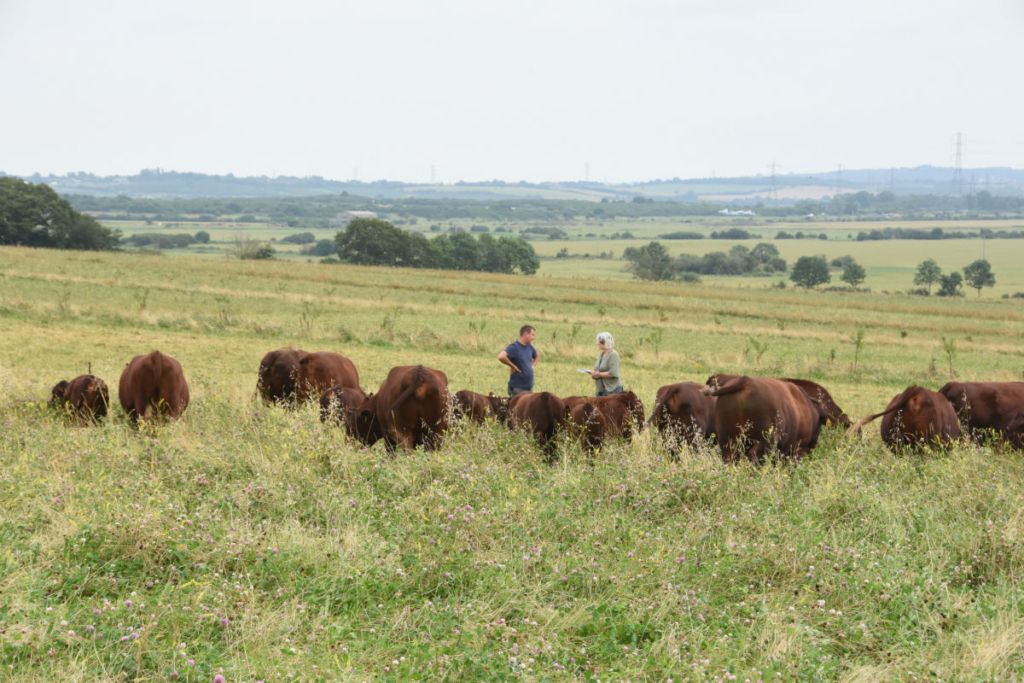
Written by Marianne Landzettel, with photographs by Martin Kunz
Get to know George more through a interview with him at Groundswell 2021 – click here to find out more
[1] Glyphosate is broad spectrum weed killer and kills all plants. Since the wheat hadn’t quite emerged when the glyphosate was sprayed, only the cover crop was terminated.


